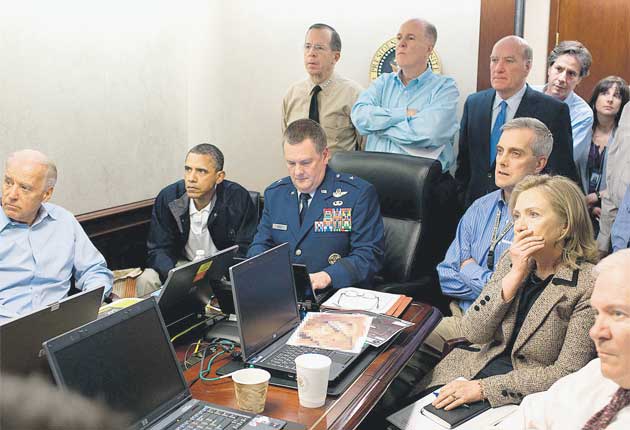Just who is the CIA mastermind who cornered Bin Laden?
He has never been photographed, and his surname is unknown. But 'John' led an extraordinary 10-year mission. David Usborne reports

There are enough people in Washington who know who "John" is, including President Barack Obama and all of his top security team. Members of the Senate Intelligence Committee won't forget him any time soon, because of the way he almost choked up when he testified before them recently. And people of his sort don't usually do that.
As for the rest of us, we must satisfy ourselves for now with a deliberately obscured portrait of this man. His story is gripping and made all the more so because all of it happened. And it culminates in decisions that could have sunk a presidency; instead they may have rescued one.
He may be murky – even his age has not been revealed and "John" is really his middle name – but we do now know of his existence. This, according to a report from the Associated Press, is the man who for almost a decade pursued doggedly every conceivable lead in the hunt for Osama bin Laden at the CIA and who finally persuaded his then boss, Leon Panetta, and President Obama that he had found him.
It actually wasn't until 2003 that "John" joined the counter-terrorism unit at the CIA that was tasked directly with finding America's Public Enemy Number One. Before that he had been working in the Balkan and Russian departments and had made his mark authoring what was seen as the definitive profile of Vladimir Putin.
He found a team that was already lost in a warren of dead-ends and disappointments. Everyone knew that Bin Laden had slipped the noose when US forces closed in on him in Afghanistan's Tora Bora mountains in late 2001, weeks after 9/11. It was assumed he had escaped into western Pakistan across the border. As for solid leads, they had none.
Over the years, CIA directors came and went and so did members of the Bin Laden search unit. Convention in the agency dictated revolving people regularly and ensuring that important problems were periodically given fresh sets of eyes.
"John" was offered transfers and promotions, but he declined repeatedly. He wouldn't let Bin Laden go. Doggedly, he logged every tiny piece of information that seemed credible, waiting and waiting. "Just keep working that list bit-by-bit," one senior intelligence official who spoke to the AP recalled "John" telling his team.
"He's there somewhere. We'll get there." His skill in analysing every clue also hasn't been forgotten by John McLaughlin, a former CIA deputy director who agreed to speak on the record. "He could always give you the broader implications of all these details we were amassing," he said. After the 9/11 attacks, "John" was among those who regularly gave Mr McLaughlin his morning briefings.
Even some top CIA insiders were sometimes unsure who "John" was exactly, even if he was engaged in the same work as them and seemed uncommonly plugged in. "I knew he was the guy in the room I always listened to," one former senior official admitted. The big break came when Abu Ahmed al-Kuwaiti , who had been identified as a possible al-Qa'ida courier, showed up on a National Security Agency wire-tap in 2010. A colleague of "John"'s sent out an email to a select few with the headline, "Closing in on Bin Laden Courier". In it she said for the first time that Bin Laden may not be in the mountains, but close to Islamabad. After the al-Kuwaiti link was developed further, "John" sent out his own memo, with restricted circulation, its subject line: "Anatomy of a Lead". Mr Panetta had become sufficiently persuaded to bring the information directly to the President.
"John"'s team kept squirreling; identifying six other people who might be in the compound in Abbottabad. Yet, whichever way they shuffled the cards, the same conclusion was always reached – it was more likely to be him than anyone else. But, according to one senior official, he never told his team members to stop searching for reasons to believe otherwise. "Right up to the last hour," he told them, "if we get any piece of information that suggests it's not him, somebody has to raise their hand before we risk American lives."
That did not happen and "John" could only tell Mr Panetta and Mr Obama the plain truth: this was best chance that America had had since 9/11 to get the man responsible for it. That window of opportunity would not stay open for ever. And, yes, there was a chance they were wrong and it would not be Bin Laden. The risk that that presented hardly needed to be spelled out and was pounding on the minds of Mr Obama and all his security officials as they watched the Navy SEALS go in from the Situation Room on that second day of May.
That picture, by the way, if the angle had been a little wider, would have revealed the furrowed face of the man from the CIA whom we will only know as "John". He was there too, sharing in the agony and, finally, the ecstasy of all that unfolded that day.
And when, days later, Mr Panetta went before the Intelligence Committee to brief members on the triumph in Abbottabad, there he was again. And Mr Panetta chose that moment to give "John" his due, asking him to give the senators the fullest version of the tracking down of Bin Laden.
It was just as he was finishing; when he knew he had been right all along, that he began to choke up.
Subscribe to Independent Premium to bookmark this article
Want to bookmark your favourite articles and stories to read or reference later? Start your Independent Premium subscription today.

Join our commenting forum
Join thought-provoking conversations, follow other Independent readers and see their replies